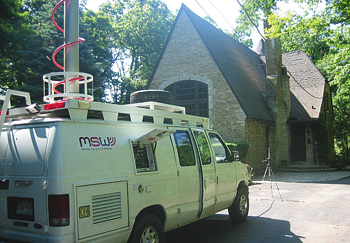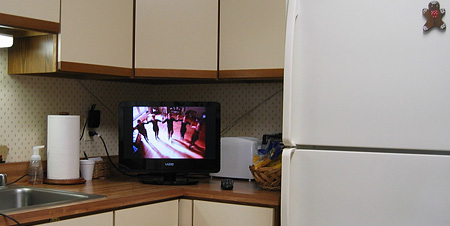Troubleshooting DTV Reception
SEATTLE
Since the DTV transition on June 12, there has been a lot written and a lot of chatter about reception difficulties of DTV over channels 7-13, in the upper VHF band. The two solutions identified to rectify this include a power increase or moving to a UHF channel.
According to an FCC spokewoman only a “handful” of stations have requested more power or a move to a UHF channel, pointing out that these requests are not public information. Stations in communities as small as Colorado Springs to major markets such as Chicago and Boston have requests in to the FCC to move back to the UHF band. And judging by the activities of consultants evaluating VHF station transmission issues around the country, more such requests could certainly be on the way.
Gary Sgrignoli, a DTV transmission consultant at Meintel, Sgrignoli, & Wallace, has been retained by a number of VHF DTV broadcasters around the country to assess their transmission and reception issues. He and his crew visit homes in a particular market that have complained to the station that they are not receiving upper VHF signals on their DTVs or through their converter boxes.

An MSW van tests for antenna reception outside a home. Regarding power increases for these upper VHF broadcasters, Sgrignoli said “it’s a good thing if you’re trying to overcome noise and interference, but there’s obviously a limit, including hardware costs and interference into other TV markets.” His in-the-home inspection of viewers’ DTV setups have revealed a nightmarish array of “lousy antennas,” poor antenna placement and adjustment, and radiated interference from a number of sources. Since a majority of the viewer complaints have come from indoor reception sites, this is where most of the effort has been focused.
SETTING UP
When Sgrignoli rolls up at a viewer’s home with his own technician and a station technical representative, the first task is to take a pair of outdoor baseline readings using a calibrated dipole antenna at an elevation of 30 feet, then six feet elevation, rotating the dipole to achieve maximum signal strength. A third baseline reading is taken inside the house at the viewing location. Then they start troubleshooting the viewer’s setup.
At one home there was a 19-inch flat screen DTV in the kitchen with no apparent antenna connected. When asked about the antenna, the homeowner said it was behind the TV. “His wife put it there… aesthetics,” said Sgrignoli. “But with the antenna behind the DTV set, not only did the set itself block the signal coming in from the window, it also was radiating like crazy.” After asking the homeowner to move the TV forward about 6 or 8 inches, he started to get signals. “He put the antenna up on the refrigerator next to him, got it up higher, and reception improved more. That’s a basic rule we need to teach the viewers: higher is better.”
Sgrignoli said an outdoor antenna properly aimed toward the local television transmitters, up high, is usually the best, followed by an antenna in the attic, assuming there isn’t a metal roof. But if the antenna has to be indoors, it should not be deep in the house but as close to a window as possible, preferably one that faces the transmitter sites.
While virtual channels have allowed stations to move to UHF but maintain their VHF channel branding, in which they have invested years and vast sums of promotional dollars, Sgrignoli said that has also contributed to antenna confusion. “People have no idea about what kinds of antennas to use [VHF or UHF], no idea what physical channels are actually being transmitted on.” They need to be told how to find out this vital information.
He said he’s found the same issues with many indoor antennas that do an adequate job with UHF reception but are left wanting for upper VHF channels. He’s found a real difference in the signal loss through the antennas. A $20 passive antenna he found at a discount store yielded a satisfactory 6 dB loss compared to an ideal dipole, “but we had antennas out there that had 12 and 15 dB loss, and sometimes even worse.
“We’ve seen a good share of amplified antennas in homes, and promptly have the homeowner replace them with simple passive ones. We have yet to see a need for an indoor amplified antenna, and often see them do more harm then good. These amplified antennas just amplify the external interference noise from nearby consumer products, and can also overload [just like some DTV receivers] from FM radio transmitters located near their residence.”
EVEN CABLE TV LEAKS
Stacking components, DVDs, VCRs, etc., with the analog DTV with its antenna on top, also causes radiated interference problems. Ditto for placing the antenna in close proximity with other consumer electronics devices, like cordless phone base stations.
“While these devices just might be meeting the FCC Part 15 rules for radiation [specified at 3 meters from the device], perhaps now is the time to review these Part 15 consumer radiation limits,” Sgrignoli said.
He added that often it’s a case that the viewer doesn’t know what to look for as a source of interference. “In Houston, we had a ceiling fluorescent light in a kitchen that was bad and was wiping out the entire upper VHF band when turned on. But the consumer didn’t know that was the problem.”

While this antenna placement may be aesthetically pleasing and save counter space, it is not the optimum setup for DTV reception. In another case, a woman showed them where her apartment maintenance folks had extended her cable TV coax. “We scanned with her DTV set in the kitchen and came up with a number of very noisy analog stations in the VHF band. And we said ‘wait a minute, there aren’t a lot of low-power television stations or translators around here.’ So I had my technician go over to the cable TV box, and he was able to identify the very fuzzy TV programs that we saw in the kitchen were leaking from her cable TV service and picked up by her antenna.”
Sgrignoli estimates that 40–50 percent of the homes he’s visited also have cable or satellite connectivity for their main viewing set, but have other TVs in the kitchen or bedroom where they want to watch just the network affiliate’s news or syndicated programming.
Sgrignoli gives high marks to the FCC for doing their own such tests, and said they’ve inquired about his firm’s field testing techniques and equipment. “They’re not just sitting around, twiddling their thumbs.”
To broadcasters who feel they’ve given their best effort at DTV education for viewers, the effectiveness of that education may have been more a question of timing than content. Sgrignoli said viewers seemed to get the message about the transition date, the three choices of how to receive DTV, and the coupon program. But they were overloaded, and many assumed that since they knew how to set up their analog TVs for over-the-air reception, that information for DTV was redundant.
Additionally, in the analog era a viewer could often live with a lousy antenna and incorrect antenna placement or adjustment since analog television allows a lousy picture to still be viewed (and often with decent audio). Due to the digital cliff effect, which is what provides the stunning pictures and sound when above the “magic” threshold, a lousy picture is no longer an option.
Now that they’re not getting their over-the-air TV, they may have much more incentive to listen this time. “Now is the time to restart the DTV reception education message, the sooner the better!” Sgrignoli said.
Get the TV Tech Newsletter
The professional video industry's #1 source for news, trends and product and tech information. Sign up below.
